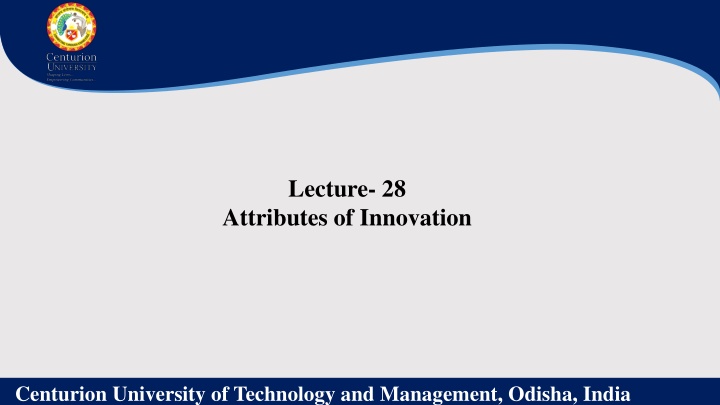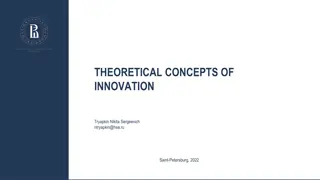
Influence of Innovation Attributes on Adoption Rates and Categories
Understand how attributes such as relative advantage, compatibility, complexity, trialability, and observability influence the rate of adoption of innovation. Explore the impact of individual perceptions and other variables on adoption rates across different innovation categories.
Download Presentation

Please find below an Image/Link to download the presentation.
The content on the website is provided AS IS for your information and personal use only. It may not be sold, licensed, or shared on other websites without obtaining consent from the author. If you encounter any issues during the download, it is possible that the publisher has removed the file from their server.
You are allowed to download the files provided on this website for personal or commercial use, subject to the condition that they are used lawfully. All files are the property of their respective owners.
The content on the website is provided AS IS for your information and personal use only. It may not be sold, licensed, or shared on other websites without obtaining consent from the author.
E N D
Presentation Transcript
Lecture- 28 Attributes of Innovation Centurion University of Technology and Management, Odisha, India
Attributes They are qualities, characteristics or tarits possessed by an object. An innovation has some qualities or characteristics . It is not intrinsic quality. Perceived attributes of innovation are- Relative advantage Compatibility Complexity Triability observability Centurion University of Technology and Management, Odisha, India
Relative advantage It is the degree we perceive innovation as better than the idea it supersedes. The relative advantage of an innovation, as perceived by members of a social system, is positively related to its rate of adoption. Compatibility It is the degree to which an innovation is perceived as consistent with the existing values, experiences, and needs of potential adopters. The compatibility of innovation, as perceived by members of a social system, is positively related to its rate of adoption. Complexity It is the degree to which we perceive innovation as difficult to understand and use. The complexity of innovation, as perceived by members of a social system, is negatively related to its rate of adoption. Centurion University of Technology and Management, Odisha, India
Trialability It is the degree to which we can experiment with an innovation limitedly. The trialability of innovation, as perceived by members of a social system, is positively related to its rate of adoption. Observability It is the degree to which the results of an innovation are visible to others. The observability of innovation, as perceived by members of a social system, is positively related to its rate of adoption. Centurion University of Technology and Management, Odisha, India
How do innovation attributes influence the rate of adoption? Individuals perceptions of these attributes predict the innovation s rate of adoption. The rate of adoption is the speed at which members of a social system use innovation. Besides the normal attributes of innovations, here are other variables affecting the rate of adoption: The type of innovation-decision (e.g., knowledge, persuasion, decision to adopt or reject, implementation, and confirmation). The nature of communication channels diffuses the innovation at various stages in the innovation-decision process (e.g., interpersonal, leader opinion, change agent, or mass media). The nature of the social system (e.g., size, characteristics, influences, components of individuals and units, leader opinion, or change agent). The extent of change agents efforts in diffusing the innovation (i.e., how influential is the change agent on changing the individuals or units opinions). The time spent to develop, commercialise, adopt and diffuse innovations. Centurion University of Technology and Management, Odisha, India
How do innovation attributes influence innovation categories? In the innovation lifecycle, innovations progress from introduction to growth to maturity and discontinuity, influenced by the innovation attributes and the perception of buyers or categories. 1. Pre-launching category: this comprises Labs, research centres, and universities that conduct research and advance knowledge of technologies to solve practical problems. These players can theoretically develop rough solution technologies with outlined prototypes and drawings. 2. Launching category: this comprises innovators or techies who are business entities aiming at advancing rough technologies developed by researchers. Techies can produce technologies with more marketable attractions but with a limited scope of adoption. 3. Growth category: this comprises early adopters who invest in technologies invented by techies to produce technology products and applications. In this stage, the progress of adoption is picking up, innovation attributes are completed as technology products, and applications Centurion University of Technology and Management, Odisha, India
4. Advanced growth category: this comprises mainly the early majority of the market streams. In this stage, technology products and applications invested by early adopters will go stream by the early majorities who create technology platforms 5. Late growth and maturity category: this comprises late majorities (conservatives) and laggards. In this stage, the market begins to saturate and mature, where late majorities conduct sustainable activities 6. Decline category: this comprises laggards. The final stage is decline, where laggards encourage internal and external capital to maintain the growth of their businesses. Centurion University of Technology and Management, Odisha, India






















